Lincoln Navigator: Seatbelt Systems / Locked Seatbelt Retractor Releasing. General Procedures
Repair
NOTE: If the seatbelt webbing does not extract from the seatbelt retractor from the stowed position, this may be due to a normal condition which happens when the seatbelt retracts at a high rate of speed. Follow these steps to release the seatbelt.
Front row seatbelt retractor
NOTE: Typical front outboard seatbelt retractor shown, other configurations similar.
NOTE: To unlock the seatbelt retractor, only a few millimeters of seatbelt are necessary to retract back onto the seatbelt retractor spool.
-
Slowly lower the seatbelt shoulder height adjuster
allowing the seatbelt to retract back onto the seatbelt retractor spool.
If the seatbelt shoulder height adjuster is all the way down, proceed
to step 3.
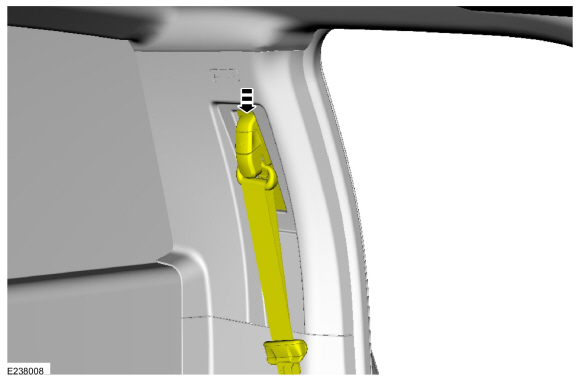 |
-
Slowly extract the seatbelt from the seatbelt
retractor. If the seatbelt does not extract, proceed to the next step.
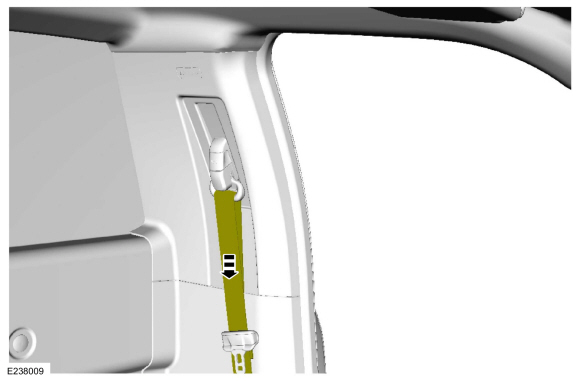 |
-
Firmly pull and extract as much seatbelt from the seatbelt retractor as possible.
 |
-
-
Slowly feed the seatbelt slack back into the retractor to unlock it.
-
Slowly extract the seatbelt from the seatbelt retractor. If the seatbelt does not extract, proceed to the next step. If the seatbelt does extract, proceed to step 8.
-
Slowly feed the seatbelt slack back into the retractor to unlock it.
-
Remove the fastener and detach the seatbelt anchor
or seatbelt anchor and pretensioner. REFER to the appropriate removal
and installation procedure in this section.
-
-
Slowly feed the seatbelt slack back into the retractor to unlock it.
-
Slowly extract the seatbelt from the seatbelt retractor. Proceed to the next step.
-
Slowly feed the seatbelt slack back into the retractor to unlock it.
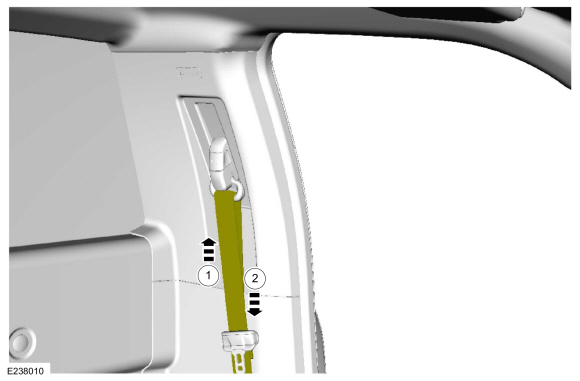 |
-
-
If the seatbelt does not extract, install
a new seatbelt retractor. Refer to the appropriate seatbelt retractor
removal and installation procedure in this section.
-
If the seatbelt does extract, install all
fasteners that were removed and tighten them to specification. REFER to
the appropriate removal and installation procedure.
-
If the seatbelt does not extract, install
a new seatbelt retractor. Refer to the appropriate seatbelt retractor
removal and installation procedure in this section.
-
Check the active restraint system for correct operation by carrying out the appropriate functional test.
Refer to: Seatbelt Systems (501-20A Seatbelt Systems, Diagnosis and Testing).
Rear seatbelt retractor
NOTE: Typical rear outboard seatbelt retractor shown, other configurations similar.
NOTE: To unlock the seatbelt retractor, only a few millimeters of seatbelt are necessary to retract back onto the seatbelt retractor spool.
-
Slowly pull the seatbelt out as far out as possible.
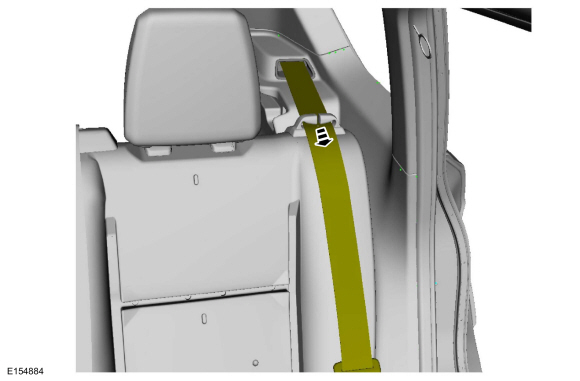 |
-
-
NOTE: Compressing the backrest foam and/or reclining the rear seat backrest (if equipped) allows more slack of the seatbelt webbing to be fed into the seatbelt retractor.
Compress the backrest foam pad and recline the rear seat backrest (if equipped).
-
Slowly feed the seatbelt slack back into the
retractor to unlock it. If the seatbelt does not extract after carrying
out this step, proceed to the next step.
-
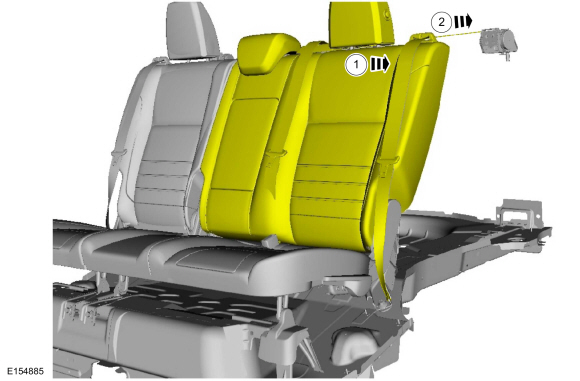 |
-
Firmly pull and extract as much seatbelt from the seatbelt retractor as possible.
 |
-
-
Slowly feed the seatbelt slack back into the retractor to unlock it.
-
Slowly extract the seatbelt from the seatbelt retractor. If the seatbelt does not extract, proceed to the next step. If the seatbelt does extract, proceed to step 16.
-
Slowly feed the seatbelt slack back into the retractor to unlock it.
-
Remove the fastener and detach the seatbelt anchor
or inflatable seatbelt union (if equipped). REFER to the appropriate
removal and installation procedure in this section.
-
-
Slowly feed the seatbelt slack back into the retractor to unlock it.
-
Extract the seatbelt webbing from the seatbelt retractor. Proceed to the next step.
-
Slowly feed the seatbelt slack back into the retractor to unlock it.
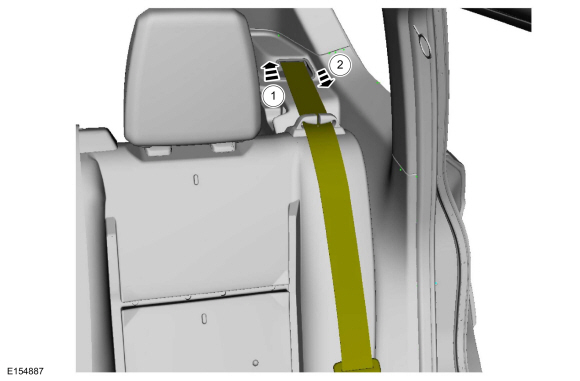 |
-
-
If the seatbelt does not extract, install
a new seatbelt retractor. Refer to the appropriate seatbelt retractor
removal and installation procedure in this section.
-
If the seatbelt does extract, install all
fasteners that were removed and tighten them to specification. REFER to
the appropriate removal and installation procedure.
-
If the seatbelt does not extract, install
a new seatbelt retractor. Refer to the appropriate seatbelt retractor
removal and installation procedure in this section.
-
Check the active restraint system for correct operation by carrying out the appropriate functional test.
Refer to: Seatbelt Systems (501-20A Seatbelt Systems, Diagnosis and Testing).
 Seatbelt Systems. Diagnosis and Testing
Seatbelt Systems. Diagnosis and Testing
Global Customer Symptom Code (GCSC) Chart
Diagnostics in this manual assume a certain skill level and knowledge of Ford-specific diagnostic practices...
 Seatbelt Cleaning. General Procedures
Seatbelt Cleaning. General Procedures
Cleaning
WARNING:
Do not bleach or re-dye the seatbelt webbing, as the webbing
may weaken. Failure to follow this instruction may increase the risk of
serious personal injury or death in a crash...
Other information:
Lincoln Navigator 2018-2025 Workshop Manual: Running Board. Removal and Installation
Removal NOTE: Removal steps in this procedure may contain installation details. LH side shown, RH side similar. With the vehicle in NEUTRAL, position it on a hoist. Refer to: Jacking and Lifting (100-02 Jacking and Lifting, Description and Operation)...
Lincoln Navigator 2018-2025 Workshop Manual: Windshield Washer Pump. Removal and Installation
Special Tool(s) / General Equipment Fluid Suction Gun Materials Name Specification Motorcraft® Premium Windshield Wash Concentrate with BitterantZC-32-B2 WSS-M14P19-A Removal Open the windshield washer reservoir lid...
Categories
- Manuals Home
- 4th Gen Lincoln Navigator Service Manual (2018 - 2025)
- Brake Service Mode Activation and Deactivation. General Procedures
- Windshield Washer Pump. Removal and Installation
- Second Row Seat. Removal and Installation
- Body Control Module (BCM). Removal and Installation
- SYNC Module [APIM]. Removal and Installation
Rear Drive Halfshafts. Diagnosis and Testing
Preliminary Inspection
Visually inspect the CV joints, housing, boots, and clamps for obvious signs of mechanical damage.If an obvious cause for an observed or reported concern is found, correct the cause (if possible) before proceeding to the next step
If the cause is not visually evident, verify the symptom and REFER to Symptom Chart: NVH.
